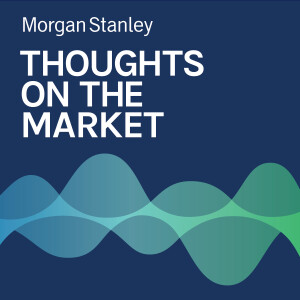
Andrew Sheets: Why Are Rates Up and Stocks Down?
 2023-08-04
2023-08-04
Moves by the Bank of Japan, the downgrade of the U.S. credit rating and new economic data may all have contributed to a spike in bond yields and fall in stock prices.
----- Transcript -----
Welcome to Thoughts in the Market. I'm Andrew Sheets, Fixed Income Strategist for Morgan Stanley. Along with my colleagues bringing you a variety of perspectives, I'll be talking about trends across the global investment landscape and how we put those ideas together. It's Friday, August 4th at 2 p.m. in London.
After a placid July, August has opened with a bout of volatility. In one sense, this isn't unusual. July is historically one of the best months of the year for global equity performance, August and September are two of the worst.
But the way markets have weakened has been more striking. Long term bond yields rose sharply this week, with the U.S. 30 year bond yield rising 27 basis points over the course of the last five days. Long term rates in the UK and Germany also rose sharply. Equity markets fell.
Those facts are clear and indisputable. But why interest rates rose so much, and whether they're responsible for equity weakness? That, ladies and gentlemen of the jury, is a lot less clear.
Indeed, there's more than one driver of last week's events. Maybe it's the Bank of Japan, which late last week raised the effective cap on Japanese government bond yields, which went on to rise sharply over the course of this week. Maybe it's the Fitch rating agency, which on Tuesday downgraded the credit rating of the United States by one notch to AA+. And maybe it's the US economic data, which has been quite strong, something that usually corresponds to higher rates.
There's also the way that yields have risen. While long term U.S. interest rates rose sharply, shorter two year yields barely budged over the last week and in the UK and Germany, those two year yields actually fell. The large move higher in U.S. rates has also occurred while the market's actually lowered its assumption about long run inflation, another unusual occurrence.
In reality, the drivers of these recent events might be all of the above. The initial rise in U.S. yields matched the move higher in Japanese rates, almost one for one. But we do think that move in Japanese rates is now mostly complete. The timing of Fitch's downgrade, which was somewhat unusual, given that there hasn't been any recent legislation to change fiscal policy and the fact that it happened at the start of August, a month that often sees less liquidity, might have given it an outsized impact. And the economic data has been good, suggesting that the U.S. economy for now is handling higher rates, a development that would generally support higher yields and a steeper curve.
And in terms of the global equity reaction, some perspective is probably helpful. While last week saw higher yields and lower prices, since early April, both nominal yields, real yields and global stock prices have all risen together and by quite a bit. Now, it's possible that this relationship between stocks and bonds shifted some this week based on simply how much equity valuations have appreciated, as my colleague Mike Wilson, Morgan Stanley's Chief Equity Strategist, has noted recently. Higher yields make a focus on valuation more important and also make it more essential that good data, the best version of that higher yield story, continues to come through. In bonds, meanwhile, the recent rise in yields is boosting expected returns going forward. On Morgan Stanley's base case forecast, the U.S. ten year Treasury through the middle of 2024 will return over 10%.
Thanks for listening. Subscribe to Thoughts of the Market on Apple Podcasts or wherever you listen, and leave us a review. We'd love to hear from you.
More Episodes
 2023-07-07
2023-07-07
 2023-07-05
2023-07-05
 2023-06-29
2023-06-29
 2023-06-26
2023-06-26
 2023-06-16
2023-06-16
 2023-06-14
2023-06-14
Create your
podcast in
minutes
- Full-featured podcast site
- Unlimited storage and bandwidth
- Comprehensive podcast stats
- Distribute to Apple Podcasts, Spotify, and more
- Make money with your podcast
It is Free
- Privacy Policy
- Cookie Policy
- Terms of Use
- Consent Preferences
- Copyright © 2015-2024 Podbean.com




